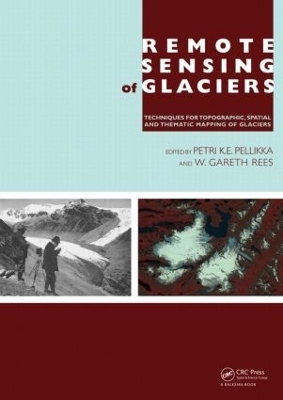
Remote Sensing of Glaciers
CRC Press (Verlag)
978-0-415-40166-1 (ISBN)
Glaciers and ice sheets have been melting significantly during recent decades, posing environmental threats at local, regional and global scales. Changes in glaciers are one of the clearest indicators of alterations in regional climate, since they are governed by changes in accumulation (from snowfall) and ablation (by melting of ice). Glacier changes have been measured for the last century by traditional field measurements, resulting in long time series for a few glaciers. Remote sensing data and methods, and geographic information systems, provide the means to allow glacier changes to be monitored at a global scale, to be analysed rapidly and to store the results and present information to both scientific and popular audiences in a way which was not possible before the digital revolution. Remote sensing of glaciers began with terrestrial and aerial photography during the middle of the 20th century, but today the discipline embraces a large variety of data types from laser scanner data to very high resolution satellite imagery, which can be applied to the mapping of glacier changes in terms of area, surface zonation or thickness. This book highlights the history of the remote sensing of glaciers, the physics of glaciers and remote sensing of them, and focuses particularly on modern data and methods used by remote sensing specialists and glaciologists. The book presents examples of glacier research carried out, for example in the Alps, Norway, Iceland, Caucasus, Patagonia, Rocky Mountains, Pakistan, Antarctica, New Zealand, and Svalbard.
This book is of interest to specialists and students working in the field of remote sensing, glaciology, physical geography, geology and climate change.
Petri Pellikka obtained his B.Sc. and M.Sc. degrees at the University of Helsinki, Finland, specializing in Physical geography and Development geography. He carried out his Ph.D. studies at the University of Munich, Germany and at the University of Oulu, Finland, on airborne video camera sensor calibration and its application in studies of forest phenology in the German Alps. Dr. Pellikka has been a professor of geoinformatics at the Faculty of Science of the University of Helsinki since 2002. He leads the GeoInformatics Research Group of 10 researchers and Ph.D. students at the Department of Geosciences and Geography. His current research activities are on remote sensing of forest, land cover and land use changes in East Africa, particularly Kenya. He has published over 110 scientific papers and over 40 popular articles. Gareth Rees studied Natural Sciences as an undergraduate, specialising in Physics, and Radio Astronomy for his PhD, at the University of Cambridge. Since 1985 he has been a member of the academic staff at the Scott Polar Research Institute (SPRI), specialising in the application of spaceborne and airborne remote sensing techniques to the investigation of polar environments. He directs the Polar Landscape and Remote Sensing Group at SPRI. The work of this group includes field-based investigation of glaciers and ice caps in Svalbard and Iceland and laboratory-based studies of snow and terrestrial ice in other parts of the world including Siberia and the Caucasus Mountains. The group also has a major research focus on the dynamics of high-latitude vegetation (tundra and the northern part of the boreal forest) and its response to global climate change, and Dr Rees is the co-director of a core project of the International Polar Year that is investigating the Arctic treeline region. Dr Rees conducts frequent fieldwork in Svalbard and in northern Russia. He has published seven books and over 70 scientific
Foreword, Acknowledgments, Author biography, Preface: Remote sensing of glaciers – glaciological research using remote sensing, Abbreviations, 1 Principles of remote sensing, 2 The formation and dynamics of glaciers, 3 Glacier parameters monitored using remote sensing, 4 The early history of remote sensing of glaciers, 5 Physics of glacier remote sensing, 6 Terrestrial photogrammetry in glacier studies, 7 Aerial photogrammetry in glacier studies, 8 Optical remote sensing of glacier extent, 9 SAR imaging of glaciers, 10 Airborne laser scanning in glacier studies, 11 Ground-penetrating radar in glaciological applications, 12 Detection and visualization of glacier area changes, 13 Detection of distortions in digital elevation models: simultaneous data acquisition at Hintereisferner glacier, 14 Accuracy aspects in topographical change detection of glacier surface, 15 The role of remote sensing in worldwide glacier monitoring, 16 Conclusions, Copyrights for figures, Authors, Reviewers, Subject index, Colour plates
| Erscheint lt. Verlag | 16.12.2009 |
|---|---|
| Verlagsort | London |
| Sprache | englisch |
| Maße | 174 x 246 mm |
| Gewicht | 839 g |
| Themenwelt | Naturwissenschaften ► Geowissenschaften ► Geografie / Kartografie |
| Naturwissenschaften ► Geowissenschaften ► Geologie | |
| ISBN-10 | 0-415-40166-6 / 0415401666 |
| ISBN-13 | 978-0-415-40166-1 / 9780415401661 |
| Zustand | Neuware |
| Haben Sie eine Frage zum Produkt? |
aus dem Bereich


